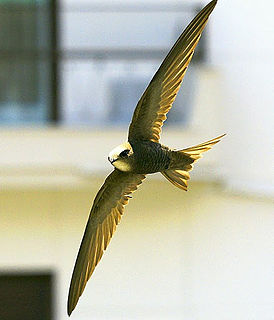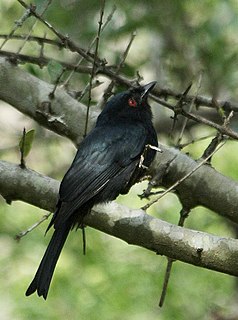
The common swift is a medium-sized bird, superficially similar to the barn swallow or house martin but somewhat larger, though not stemming from those passerine species, being in the order Apodiformes. The resemblances between the groups are due to convergent evolution, reflecting similar contextual development. The swifts' nearest relatives are the New World hummingbirds and the Southeast Asian treeswifts.

The swifts are a family, Apodidae, of highly aerial birds. They are superficially similar to swallows, but are not closely related to any passerine species. Swifts are placed in the order Apodiformes with hummingbirds. The treeswifts are closely related to the true swifts, but form a separate family, the Hemiprocnidae.

The alpine swift formerly Apus melba, is a species of swift found in Africa, southern Europe and Asia. They breed in mountains from southern Europe to the Himalaya. Like common swifts, they are migratory; the southern European population winters further south in southern Africa. They have very short legs which are used for clinging to vertical surfaces. Like most swifts, they never settle voluntarily on the ground, spending most of their lives in the air living on the insects they catch in their beaks.

The little swift, is a small species of swift found in Africa and southwestern Asia, and are vagrants and local breeders in southern Europe. They are found both in urban areas and at rocky cliffs where they build nests in a way typical of all members of the order Apodiformes. The genus name Apus is Latin for a swift, thought by the ancients to be a type of swallow without feet. The Latin specific affinis means similar to or related to, but in this case the species that the little swift supposedly resembles is not clear from the description. A population formerly considered to be an eastern subspecies of little swift is now separated as a distinct species, the house swift.

The pallid swift is a small bird, superficially similar to a barn swallow or house martin. It is, however, completely unrelated to those passerine species, since the swifts are in the order Apodiformes. The resemblances between the groups are due to convergent evolution reflecting similar life styles.

The Pacific swift is a species of bird that is part of the Swift family. It breeds in eastern Asia. It is strongly migratory, spending the northern hemisphere's winter in Southeast Asia and Australia. The general shape and blackish plumage recall its relative, the common swift, from which it is distinguished by a white rump band and heavily marked underparts. The sexes are identical in appearance, although young birds can be identified by pale fringes to the wing feathers that are absent in adults. This swift's main call is a screech typical of its family. It is one of a group of closely related Asian swifts formerly regarded as one species.

The common square-tailed drongo, formerly the square-tailed drongo, is a passerine bird in the family Dicruridae. It is a common resident breeder in parts of southern Africa.

The brown-backed needletail, or brown needletail, is a large swift.

The plain swift is a medium-sized swift. Although this bird is superficially similar to a barn swallow or house martin, it is not related to those passerine species. The resemblances between the groups are due to convergent evolution reflecting similar life styles.

The white-rumped swift is a species of swift. Although this small bird is superficially similar to a house martin, it is not closely related to that passerine species. The resemblances between the swallows and swifts are due to convergent evolution reflecting similar life styles.

The African black swift, also known as the African swift or black swift, is a medium-sized bird in the swift family. It breeds in Africa discontinuously from Liberia, Cameroon, Zaire, Uganda and Kenya southwards to South Africa. The "black swifts" of Madagascar and the Comoros are either taken as two subspecies of the African black swift, or otherwise deemed a full species, the Malagasy black swift.
The Cape Verde swift or Alexander's swift is a small bird of the swift family found only in the Cape Verde Islands. It has been recorded from all the islands except Santa Luzia although it probably breeds only on Santiago, Fogo, Brava, Santo Antão and São Nicolau. It is generally common with a stable population and is not considered to be threatened. The name Alexander's swift commemorates Boyd Alexander, an English ornithologist who led two expeditions to the islands in 1897.
Bates's swift is a species of small swift in the family Apodidae which is found in western Africa.
Fork-tailed swift is the historic name of a kind of bird which has since been divided taxonomically into four species. It could refer to any of four different species of swifts:
Salim Ali's swift is a small bird, superficially similar to a house martin. It is, however, completely unrelated to those passerine species, since swifts are in the order Apodiformes. The resemblances between the groups are due to convergent evolution reflecting similar life styles.
Blyth's swift, is a small bird, superficially similar to a house martin. It is, however, completely unrelated to those passerine species, since swifts are in the order Apodiformes. The resemblances between the groups are due to convergent evolution reflecting similar life styles.










